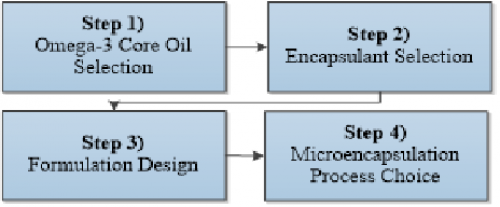If you would like to see more information on this case study, click here!
You can request this case study and a WCDE staff member will get back to you.
Some fatty acids, particularly omega-6 and omega-3, are considered essential fatty acids, as the human body cannot produce this group of polyunsaturated fatty acids (PUFA) and intake must occur through diet. Research studies have shown strong evidence that consumption of omega-3 fatty acids may improve resistance to cardiovascular disease (CVD) and rheumatoid arthritis. Foods with high concentrations of unsaturated fatty acids include seeds, nuts, certain fruits, vegetable oil and fish. Since consumption of naturally occurring fatty acids remains low in Western countries, omega-3 fatty acids are increasingly added to foods such as cereals, cookies, and long shelf-life products. Functional foods are enriched with ingredients that provide added function to the finished product, most often related to health-promotion or disease prevention. Microencapsulation is a technology used to fortify foods with omega-3 fish oil as outlined in Figure 1. Various fish oil microencapsulation technologies are available, including spray-dried emulsions, complex coacervation, alginate-based microspheres, submerged coextrusion, melt injection, calcium carbonate capsules, and γ-cyclodextrins. While such fortification can provide benefits, there are also drawbacks: these oils are highly susceptible to oxidation, which can negatively impact product flavour and reduce shelf-life.

Veronica Wong, a 3rd year University of Waterloo Chemical Engineering student, investigated the microencapsulation production process during a work term at the University of Waterloo. To provide context, she considered a fictitious company, Cookies"R"Us, which was considering a commercially available omega-3 PUFA process for cookie fortification.
The teaching objective of this case is to illustrate topics in critical thinking, design, research, and food fortification. The case study could be used in courses in nutrition, food science, biology and biochemistry. The case could be used as a conceptual design case for CHE 100 (Chemical Engineering Concepts). It could also be used to complement lecture material, specifically in CHE 161 (Engineering Biology) and CHE 564 Food Process Engineering.
If you would like to see more information on this case study, click here!
You can request this case study and a WCDE staff member will get back to you.
Contact Waterloo Cases in Design Engineering
Steve Lambert
Tel: (519) 888-4728
Email: steve@uwaterloo.ca
The University of Waterloo acknowledges that much of our work takes place on the traditional territory of the Neutral, Anishinaabeg and Haudenosaunee peoples. Our main campus is situated on the Haldimand Tract, the land granted to the Six Nations that includes six miles on each side of the Grand River. Our active work toward reconciliation takes place across our campuses through research, learning, teaching, and community building, and is co-ordinated within the Office of Indigenous Relations.